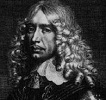Samuel Pepys Diary, 1663
Oct. 30. At my periwig-maker's, and there showed my wife the periwig
made for me.
Nov. 2. I heard the Duke say that he was going to wear a periwig;
and they say the King also will. I never till this day observed that
the King is mighty gray.
Nov. 3. Home, and by and by comes Chapman, the periwig-maker,
and upon my liking it, without more ado I went up, and there he cut
off my hair, which went a little to my heart at present to part with
it; but, it being over, and my periwig on, I paid him 3 pounds for it;
and away went he, with my own hair, to make up another of it.
Nov. 8. (Lord's day). To church, where I found that my coming
in a periwig did not prove so strange as I was afraid it would, for
I thought that all the church would presently have cast their eyes all
upon me, but I found no such thing.
 1659 1659
Colonel John Russel Wright in a falling band over the buffcoat. The
thick tassels are showing. England. |
 1660 1660
The famous of the Dutch gentleman shows a large falling band of
fine linen edged with broad lace. The pleats going around the corner
are well visible. Holland. |
 1660 1660
French engraving of a very fashionable gentleman wearing a full
lace falling band with long double tassels on the ties. France. |
 1660 1660
Saltonstall is wearing a short doublet and depicted here in an
old fashioned wide and stiff collar that is open in the front and
edged with a narrow, scalloped lace. England. |
 The
second Duke of Buckingham in a very full and frizzy blond wig, a type
of wig which seemed to be fashionable only for a short while. His
falling band shows no tassels and the ties are hidden The lace edging
is extremely broad. England. The
second Duke of Buckingham in a very full and frizzy blond wig, a type
of wig which seemed to be fashionable only for a short while. His
falling band shows no tassels and the ties are hidden The lace edging
is extremely broad. England. |
 Gentleman
with a mixture of an earlier and later falling band. It is soft but
wide and open at the front, showing tassels. England. Gentleman
with a mixture of an earlier and later falling band. It is soft but
wide and open at the front, showing tassels. England. |
 Admiral
de Ruyter in a very pristine and moderate pure linen collar, representing
the restraint of the Protestant Netherlands. Holland. Admiral
de Ruyter in a very pristine and moderate pure linen collar, representing
the restraint of the Protestant Netherlands. Holland. |
 Gentleman
in a very long curly wig and equally long and narrow lace falling
band. Towards the mid 1660s. Nationality indeterminate. Gentleman
in a very long curly wig and equally long and narrow lace falling
band. Towards the mid 1660s. Nationality indeterminate. |
 The
Duke of Lauderdale towards the end of the decade, probably 1667 or
68, not in a falling band anymore, but a cravat, the line is just
visible at his neck and the lace that is used has changed too. Not
the soft bobbin lace anymore, but the boldly patterned three dimensional
venetian Gros point needlepoint. England. The
Duke of Lauderdale towards the end of the decade, probably 1667 or
68, not in a falling band anymore, but a cravat, the line is just
visible at his neck and the lace that is used has changed too. Not
the soft bobbin lace anymore, but the boldly patterned three dimensional
venetian Gros point needlepoint. England. |
 Caricature
of fashion by Roman de Hooghe, end of the decade. The gentleman wears
a cravat with broad lace ends and the cravat is either knotted in
a small knot or simply held together with silk ribbons. Nationality
indeterminate since it is a caricature. Caricature
of fashion by Roman de Hooghe, end of the decade. The gentleman wears
a cravat with broad lace ends and the cravat is either knotted in
a small knot or simply held together with silk ribbons. Nationality
indeterminate since it is a caricature. |
 1661 1661
James, Duke of York by Peter Lely in an unusual cravat for so
early a year. He is dressed though similar to the flowing robes of
the court beauties, due to the fact he was painted by Lely. Therefore
he appears to be in undress rather than outdoor garments and the long
soft linen and lace cravat is knotted loosely. England. |
 1661 1661
James, Duke of York in a far more formal portrait, wearing a large
linen falling band. The way it is shaped is good to see in profile
with the front longer. He wears his natural hair. England. |
 1662 1662
The gentleman is dressed soberly and appears to be a Dutch Protestant.
His falling band is reminiscent of the earlier collars and is a stiffer
linen with a lace edging. Small tassels are visible. Holland. |
 1662-65 1662-65
This young gentleman is Dutch and he is wearing a soft, large
falling band with an equally soft lace edging. Holland. |
 1665 1665
A very broad lace is attached to a small bit of linen, forming
the familiar double fold in the front. Nationality indeterminate. |
 1663 1663
Self portrait of the Dutch painter Dou, who depicts himself in
casual undress and so is his soft linen cravat, which is tied in a
simple bow. Holland. |
 1663 1663
Large and heavy needlepoint lace makes up this magnificent falling
band of Friedrich Wilhelm which appears to be starched but is merely
the effect of the heavy lace. German. |
 Prince
Rupert in the earlier part of the decade in a small falling band with
a fold in the front, made from a bobbin lace with a small all-over
(neige) pattern. England. Prince
Rupert in the earlier part of the decade in a small falling band with
a fold in the front, made from a bobbin lace with a small all-over
(neige) pattern. England. |
 1663 1663
Dutch Officer Rihel painted by Rembrandt and wearing an unusually
simple fan shaped cravat arranged over a buffcoat. The cravat itself
is a rectangular piece of linen, the fan-shaped is created by careful
arrangement. Holland. |
 1664 1664
Sir William Bruce Wright in undress, wearing a gown (banyan) and
his cravat made from soft linen with a broad lace edge is wide and
tied in a loose bow. England. |
 1664-65 1664-65
The 9th Earl of Argyll wears a large falling band with a broad
lace edging. England. |
 1665 1665
The Marquis of Tweedalle wears a fashionable cravat which consists
of broad lace edges which are held together by a silk ribbon to fall
into the tiers. England. |
 1666 1666
Very long and narrow falling band with typical front fold and
very long ties with tassels. Nationality indeterminate |
 1667 1667
The Earl of Bath in a now very fashionable cravat in a wide bow,
worn with the new coats. England. |
 1667 1667
Lord David Hay in an unusually large and broad falling band for
the end of the decade. England. |
 1667 1667
Louis XIV in a cravat with venetian Gros point lace edging and
the knot secured by red silk ribbons. France. |
 1667 1667
Robert Kerr in a very similar cravat to Louis XIV. England. |
 1667 1667
Sir Norton Knatchbull very modestly dressed in a plan line falling
band. England. |
 1667 1667
Officer at the Siege of Douain wearing a cravat in a bow with
lace edging and held by a red silk ribbon. France. |
 1669 1669
Prince Rupert wearing a cravat in a soft floppy bow. England. |
 1667-68 1667-68
Dutch gentleman in a simple linen cravat held together by black
silk ribbons. Holland. |
 1670 1670
Anne Marie Louise de Medici in a riding habit, wearing a male
falling band of the old fashioned style made from boldly patterned
lace. |
 1670 1670
Gentleman in a cravat with broad lace edges and held together
with a black silk ribbon. |
 Anthony
Ashley Cooper in a lace edged bow. England. Anthony
Ashley Cooper in a lace edged bow. England. |
 Minister
Colbert with a falling band edged with a very broad exquisite Venetian
needlepoint lace France. Minister
Colbert with a falling band edged with a very broad exquisite Venetian
needlepoint lace France. |
 Minister
Colbert in a more modest falling band. France. Minister
Colbert in a more modest falling band. France. |
 Duc
de Beaufort in the early 1660s wearing a wide and open fronted falling
band/collar. France. Duc
de Beaufort in the early 1660s wearing a wide and open fronted falling
band/collar. France. |
 Louis
XIV in the early 1660s wearing a very long falling band with a very
broad lace edge. France. Louis
XIV in the early 1660s wearing a very long falling band with a very
broad lace edge. France. |
 Louis
XIV by Le Brun in a long falling band with broad lace. France. Louis
XIV by Le Brun in a long falling band with broad lace. France. |
 Samuel
Pepys in an undress silk gown wearing a loosely knotted cravat. England. Samuel
Pepys in an undress silk gown wearing a loosely knotted cravat. England. |
 Philippe,
Monseigneur, brother of Louis XIV in a soft cravat worn in a loose
and floppy bow with broad lace edges. France. Philippe,
Monseigneur, brother of Louis XIV in a soft cravat worn in a loose
and floppy bow with broad lace edges. France. |
 Prince
Rupert in a lace edged falling band. England. Prince
Rupert in a lace edged falling band. England. |









